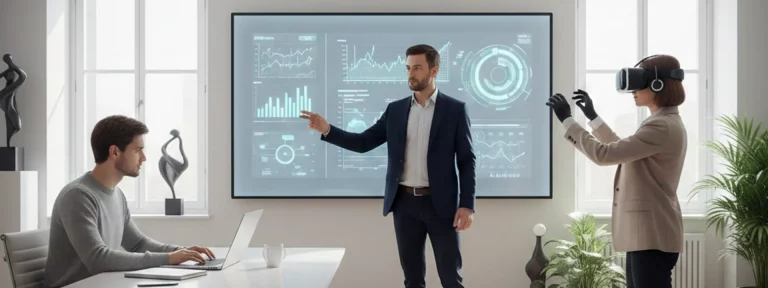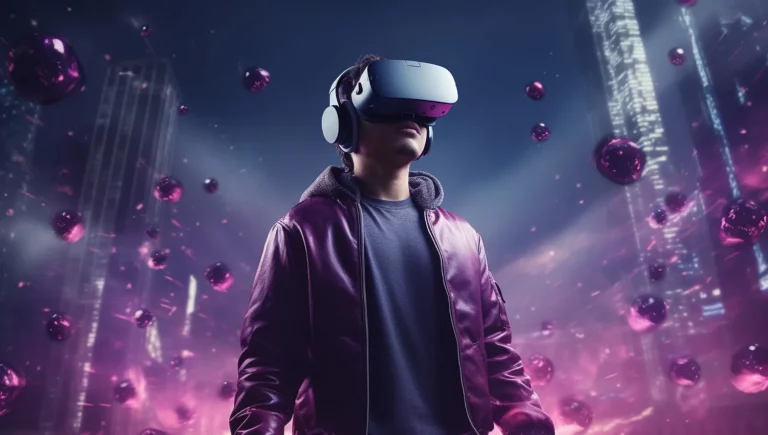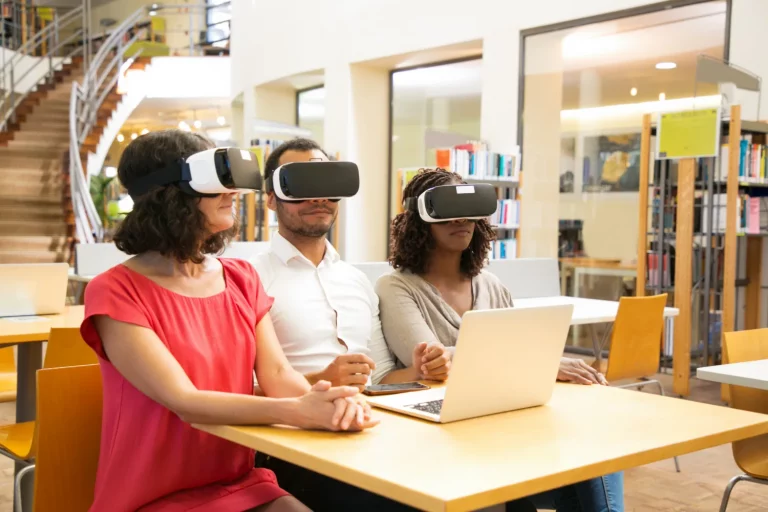Virtual reality (VR) is transforming how modern businesses train their employees. VR creates immersive learning environments where employees can practice critical skills without real-world consequences. Discover how VR training can transform your organization’s learning and development strategy.
What is VR Training?
Virtual Reality training uses simulated settings to teach technical and soft skills in an immersive, interactive context. Unlike traditional training techniques that rely on lectures, videos, or reading materials, VR training immerses learners in realistic 3D computer-generated settings, letting them practice tasks and build abilities through hands-on experience.
The technology works by having participants wear VR headsets that completely immerse them in these digital surroundings, which are usually linked with motion controllers that allow them to interact with virtual objects and scenarios. This approach creates a strong sensation of presence, making users believe they are physically there in the simulated environment. VR training accurately mimics real-world circumstances, allowing employees to practice tasks multiple times without the dangers, costs, or logistical difficulties associated with traditional training methods.
Components of VR Training
A comprehensive VR training program consists of several key components:
- Learning Design: Careful planning of objectives, scenarios, and assessment methods that align with specific organizational needs and goals.
- Virtual Environment: Detailed simulated spaces, such as factory floors, office settings, or customer service areas, where the training takes place.
- VR Modules: Software applications containing interactive simulations designed to teach specific skills or procedures.
- User Experience: The trainee’s journey through the virtual environment using headsets and controllers to complete tasks and receive feedback.
The VR Training Experience
When employees engage with VR training, they typically:
- Put on a VR headset that transports them to a realistic 3D environment.
- Use motion controllers to interact with virtual objects and scenarios.
- Navigate through guided experiences designed to build specific skills.
- Receive immediate feedback on their performance.
- Practice tasks repeatedly until mastery is achieved.
- Experience situations that might be too dangerous, expensive, or impractical to recreate in the real world.
This immersive approach to learning represents a substantial leap forward over traditional training methods, offering a more engaging, effective, and efficient path to skill development across every industry.
Key Benefits of VR Training Over Traditional Methods
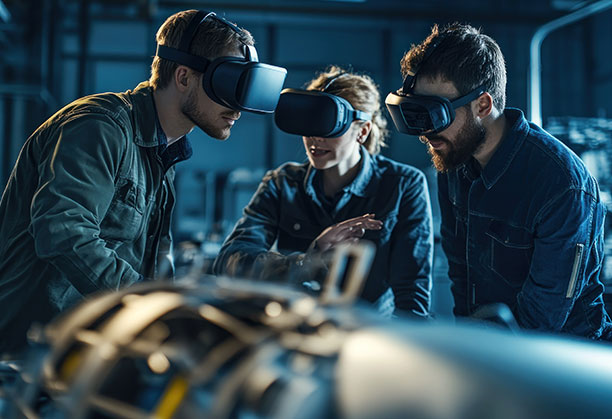
Virtual Reality training delivers a range of benefits that resolve typical issues faced by traditional training approaches. Here’s how VR transforms the business training environment:
1. Immersive Learning Experience
VR creates highly realistic simulations that strongly improve user engagement and knowledge retention. VR training builds stronger neural connections by stimulating multiple senses at the same time, compared to passive learning methods. Learners develop an emotional connection to the content, leading to higher confidence levels and a smoother transition from learning to doing.
2. Risk-Free Practice Environment
Risk-free practice for high-risk scenarios has to be one of the greatest boons of VR training. Employees trained with VR can safely perform dangerous procedures in manufacturing or construction, complex medical surgeries without patient risk, and emergency response protocols for critical situations. Moreover, they can use simulations of expensive equipment without concerns about damage. This safe environment of learning encourages experimentation and learning from mistakes.
3. Significantly Higher Retention Rates
Research shows VR learners absorb up to four times more information than traditional methods. This dramatic improvement stems from VR’s distraction-free environment and the application of learning-by-doing principles. Combining visual, auditory, and kinesthetic learning in VR creates stronger memory pathways that enhance long-term retention.
4. Unlimited Repetition Without Additional Costs
VR enables trainees to practice scenarios repeatedly until skills become second nature—a luxury often unavailable in conventional training due to time constraints, material costs, or instructor availability. This repetition builds muscle memory for technical tasks, reinforces proper procedure sequencing, develops confidence through progressive mastery, and creates mental models applicable to real-world situations.
5. Enhanced Accessibility and Flexibility
With portable VR headsets, training can happen virtually anywhere, eliminating geographical barriers and reducing travel expenses. This flexibility allows organizations to train remote teams consistently, provide on-demand learning experiences, update training content rapidly across all locations, and scale programs efficiently without logistical constraints.
6. Personalized Learning Pathways
VR training can adapt to individual learning styles, paces, and needs. Advanced systems can adjust difficulty based on user performance, provide customized feedback for improvement, focus on specific skill gaps identified during sessions, and allow learners to progress at optimal speeds.
7. Measurable Cost and Time Efficiencies
VR reduces training time by up to 40% while eliminating numerous traditional training expenses, including travel and accommodation costs, physical training materials and equipment, instructor time for repetitive sessions, and production downtime for on-site training.
8. Effective Stress Management Training
High-pressure situations can be replicated safely in VR, allowing employees to build resilience to stressful scenarios, practice emotional regulation techniques, develop confidence in crisis management, and experience realistic pressure without real-world consequences.
9. Comprehensive Analytics and ROI Tracking
VR platforms provide detailed performance data unavailable in traditional training, offering objective measurement of skill acquisition, identification of common error patterns, progress tracking across training modules, and clear metrics for calculating training ROI. These substantial benefits make VR training particularly valuable in industries requiring high-stakes decision-making, technical precision, or interpersonal skill development.
You Can Also Checkout: Difference Between VR Training and Traditional Training
Creating a Safe Learning Environment with VR

Virtual Reality training transforms traditional learning by providing consequence-free environments where employees can develop crucial skills without exposure to workplace hazards. This approach prioritizes safety while ensuring comprehensive skill development through several key mechanisms:
Risk-Free Simulation of Hazardous Scenarios
VR creates highly detailed replications of dangerous workplace situations that would be impossible or irresponsible to recreate for training purposes. Employees can safely experience and respond to chemical spills and hazardous material handling, heavy machinery malfunctions, electrical system failures, confined space operations, and working at heights. These simulations eliminate all physical risk while maintaining the psychological realism necessary for effective training.
Enhanced Hazard Recognition Training
One of the most powerful safety applications of VR is teaching employees to identify potential dangers before they become incidents. Through interactive scenarios, workers learn to spot subtle signs of equipment failure, recognize unsafe workplace conditions, identify lapses in safety protocol, and detect environmental hazards in various settings. This preventative approach builds a safety-first mindset that translates directly to on-the-job awareness.
Comprehensive Emergency Response Preparation
VR excels at replicating high-stress emergency scenarios that require quick thinking and decisive action. In a controlled environment, employees can repeatedly practice evacuation procedures, accident responses, active shooter drills, and medical emergencies. The ability to engage in these high-stakes scenarios without real-world pressure builds both the competence and confidence needed in actual emergencies.
Proper Safety Protocol Implementation
VR provides step-by-step guidance for critical safety procedures that must be performed with precision. This includes Lockout/Tagout for energy isolation, correct use of PPE, confined space entry procedures, and fall protection system handling. The immersive format helps employees remember each step and understand the underlying reasons each measure is vital to their safety.
Psychological Safety and Stress Management
Beyond physical threats, VR helps employees navigate the psychological demands of hazardous work. It provides a safe space to experience emotionally intense situations, develop effective coping mechanisms, build mental resilience through gradual exposure, and practice decision-making under pressure without real consequences. This mental training is crucial for real-world performance during emergencies.
Physically Safe Training Environment
Even the VR training setup itself prioritizes user safety. Sessions are held in obstacle-free areas with supervised guidance, designed to prevent disorientation, fatigue, falls, or collisions. Clear time limits and instructor support ensure the experience remains physically secure while delivering high-impact, immersive training.
Collaborating with VR Developers for Tailored Programs
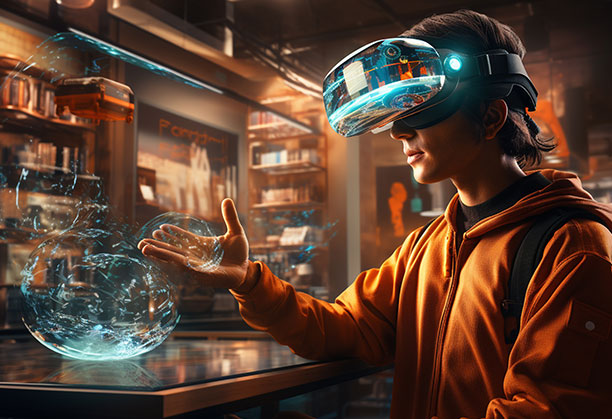
Effective VR training solutions require strategic collaboration between companies and specialized VR developers. This partnership ensures that training programs address specific organizational needs while leveraging cutting-edge technology. Here’s how successful collaborations typically unfold:
Comprehensive Needs Assessment
The foundation of effective VR training development begins with a thorough evaluation of an organization’s specific requirements:
- Skills Gap Analysis: Companies identify performance areas that would benefit most from immersive training.
- Risk Evaluation: Key safety concerns and high-consequence scenarios are prioritized for simulation.
- Learning Objective Definition: Clear, measurable goals are established for each training module.
- User Capability Assessment: The technical proficiency of the intended users shapes the interface design.
This initial phase ensures that development resources focus on areas with the highest potential impact.
Strategic Planning and Research
Once needs are identified, developers work with company stakeholders to create a comprehensive implementation strategy:
- Organizational Culture Integration: Training approaches align with existing company values and protocols.
- Hardware Selection: Appropriate VR equipment is chosen based on training requirements, budget, and scalability needs.
- Platform Compatibility: Developers ensure solutions work within the existing training infrastructure.
- Implementation Timeline: Realistic development and rollout schedules are established.
This collaborative planning process creates a shared vision between the company and the development team.
Custom Content Development
The core of VR training value comes from tailored content that reflects actual workplace scenarios:
- Environment Modeling: Developers create accurate digital replicas of relevant workspaces.
- Scenario Design: Interactive situations mirror real-world challenges employees face.
- Instructional Framework: Learning principles are incorporated to maximize knowledge transfer.
- Engagement Mechanisms: Developers integrate elements that maintain user interest and focus.
Throughout development, regular checkpoints ensure the content remains aligned with training objectives.
Iterative Testing and Refinement
Successful VR training programs evolve through systematic testing and improvement:
- Pilot Groups: Small employee cohorts test early versions and provide feedback.
- Usability Evaluation: Developers assess interface intuition and ease of navigation.
- Learning Effectiveness: Test groups demonstrate whether the training achieves desired outcomes.
- Technical Performance: Systems are optimized for smooth operation across all hardware.
This feedback loop is crucial for identifying and addressing issues before full-scale implementation.
Implementation and Training
The rollout phase requires careful coordination to ensure smooth adoption:
- Equipment Setup: Physical spaces are prepared for VR hardware installation.
- User Training: Employees learn to navigate the VR interface effectively.
- Administrator Preparation: Training managers receive instruction on program oversight.
- Support Systems: Technical assistance protocols are established for troubleshooting.
This phase transforms the developed solution into an operational training asset.
Continuous Evaluation and Improvement
Effective partnerships extend beyond initial implementation:
- Performance Metrics: Usage data and learning outcomes are tracked systematically.
- Regular Updates: Content is refreshed to reflect changing workplace requirements.
- Expansion Planning: Successful modules lead to development in additional training areas.
- Technology Upgrades: Hardware and software are updated as VR technology advances.
This ongoing relationship ensures training programs remain relevant and effective over time.
By following this collaborative approach, companies and VR developers create training solutions that address specific organizational challenges while leveraging the unique capabilities of virtual reality technology.
Customizing VR Training Across Different Industries
Virtual Reality training demonstrates remarkable versatility across sectors, with specialized applications addressing industry-specific challenges and requirements. Here’s how VR training is being customized to transform learning in diverse professional environments:
Virtual Reality training demonstrates remarkable versatility across sectors, with specialized applications addressing industry-specific challenges and requirements. Here’s how VR training is being customized to transform learning in diverse professional environments:
Healthcare
The healthcare sector has embraced VR training to improve patient outcomes and clinical competency:
- Medical Procedure Simulation: Surgeons practice complex operations on virtual patients, reducing learning curves and improving technique without patient risk.
- Patient Interaction Training: Healthcare providers develop empathy and communication skills through scenarios with virtual patients displaying various conditions and demographics.
- Emergency Response Preparation: Medical teams rehearse coordinated responses to crises like code blues or mass casualty events.
Real-World Implementation: Johnson & Johnson’s VR training program has successfully trained surgeons worldwide, addressing critical skills shortages in specialized procedures while standardizing techniques across global teams.
Manufacturing
VR transforms skills development in manufacturing environments:
- Equipment Operation: Workers master complex machinery controls in virtual environments before touching actual equipment, reducing damage risks and production interruptions.
- Assembly Line Training: Employees learn precise assembly sequences and quality control procedures through repeatable virtual practice.
- Maintenance Procedures: Technicians train on equipment teardown, troubleshooting, and repair without taking production systems offline.
Real-World Implementation: Volkswagen incorporates haptic feedback gloves in their VR training, allowing employees to feel virtual components and develop muscle memory for precise assembly tasks.
Retail
Customer-facing industries leverage VR to enhance service quality:
- Customer Interaction Scenarios: Staff practice handling difficult customer situations, from complaints to specialized product inquiries.
- Visual Merchandising Training: Employees learn optimal product placement and display techniques through virtual store environments.
- Loss Prevention Training: Security personnel identify suspicious behaviors and practice appropriate intervention techniques.
Real-World Implementation: ReadySet VR’s retail training solutions have helped major chains reduce training time while improving employee confidence in customer-facing roles.
Construction
High-risk construction environments benefit particularly from VR safety training:
- Heights and Fall Protection: Workers experience realistic elevation scenarios while practicing proper harness use and safety protocols.
- Equipment Operation: Heavy machinery training occurs in virtual environments before operators control actual equipment.
- Blueprint Interpretation: Teams visualize completed structures based on 2D plans, improving spatial understanding and reducing construction errors.
Real-World Implementation: 3M’s construction safety programs use VR to demonstrate proper fall protection techniques, significantly reducing workplace accidents among trained personnel.
Automotive
Vehicle manufacturing and service benefit from specialized VR applications:
- Electric Vehicle Training: Technicians learn safe handling procedures for high-voltage components without exposure risk.
- Complex Assembly Procedures: Workers master intricate component installation through repeated virtual practice.
- Service Diagnostics: Maintenance professionals develop troubleshooting skills across multiple vehicle models without requiring physical examples.
Real-World Implementation: Porsche uses VR to train service technicians on electric vehicle technologies, ensuring safety and competency before hands-on work with actual vehicles.
Energy Sector
High-consequence environments like offshore platforms and power generation benefit from risk-free VR training:
- Offshore Procedures: Workers practice dangerous tasks like crane operations or emergency evacuations in virtual environments.
- Power Plant Operations: Technicians train on control systems and emergency protocols without risking critical infrastructure.
- Renewable Energy Installation: Teams learn turbine assembly and maintenance procedures before working at heights.
Real-World Implementation: Vinci’s VR training programs prepare workers for offshore wind turbine operations, addressing critical skills gaps while eliminating travel to remote training facilities.
Office and Corporate Settings
Even traditional office environments leverage VR for specialized training:
- Public Speaking Practice: Employees confront presentation anxiety by practicing with virtual audiences.
- Diversity and Inclusion Training: Immersive scenarios help staff recognize unconscious bias and develop inclusion strategies.
- Crisis Management: Leadership teams practice coordinated emergency response and communication strategies.
Real-World Implementation: Major logistics companies use VR for warehouse management training, reducing onboarding time while improving operational accuracy.
Customization Strategies for Maximum Effectiveness
Regardless of industry, successful VR training customization typically involves:
- Authentic Environment Recreation: Replicating actual workspaces with high fidelity increases skill transfer.
- Industry-Specific Challenges: Incorporating common sector-specific problems builds relevant problem-solving skills.
- Appropriate Complexity Scaling: Gradually increasing difficulty as learners progress ensures continued engagement.
- Integrated Assessment Tools: Measuring specific competencies against industry standards validates training effectiveness.
By tailoring content, interaction methods, and assessment approaches to specific industry requirements, VR training delivers superior results compared to generic learning approaches.
Transform ground employee training with Juego neXR
Conclusion
Virtual Reality training represents a fundamental shift in workforce development, moving from traditional training. VR training creates safe environments for high-risk tasks, improving knowledge retention by up to 400%, reducing training time, increasing effectiveness, providing consistent experiences globally, delivering substantial cost savings, and enabling detailed performance analytics impossible with traditional methods. Organizations that embrace VR training gain competitive advantages by responding to changing workplace requirements.
Frequently Asked Questions
Development timelines typically range from 8-16 weeks for moderately complex training modules. Factors affecting the timeline include simulation complexity, level of customization required, number of interactive elements, and review cycles. Simple scenarios using existing templates can be developed more quickly, while highly detailed custom environments require longer development periods.
Yes, most employees adapt quickly to VR training. Modern VR systems feature intuitive controls and comprehensive onboarding tutorials. Most users become comfortable with basic navigation and interaction in 5-10 minutes. Initial training sessions typically include orientation time to ensure user comfort before beginning substantive training content.
ROI measurement typically combines several metrics: reduced training time, decreased error rates in actual job performance, lower accident rates, improved compliance scores, reduced travel and material costs, and accelerated time to competency. Most organizations establish baseline measurements before implementation to accurately gauge improvement.
Modern VR training platforms offer LMS integration capabilities through standards like SCORM or xAPI (Experience API). This allows for seamless tracking of completion status, assessment scores, and time spent in training. User authentication can also be synchronized between systems for streamlined access.
Yes, well-designed VR training modules are built with modification in mind. Updates can range from simple content changes (like updated protocols or procedures) to more substantial revisions involving new equipment or environments. Development partnerships typically include maintenance agreements covering regular content updates and technical support.
Absolutely. VR training is increasingly accepted by regulatory bodies in industries including healthcare, manufacturing, and transportation. The detailed tracking and consistent delivery of training content enhance compliance documentation. Organizations should consult with regulatory experts when developing programs to ensure all requirements are met.
Revolutionize the future of business with Juego neXR
Related Posts
Share this Article:
Our Offices

India
Bangalore
GR Grand Plaza, 2nd Floor, JP Nagar, 6th Phase, Bangalore – 560 078

KSA
Jeddah
St Idris Square, 4036 Helmi Koutbi, Al Zahra, Jeddah 23425, Saudi Arabia
Follow Us On:
© 2025 Juego neXR. All Rights Reserved.
